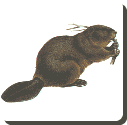 Beaver — Beavers are semi-aquatic rodents native to North America and Europe. They are the only living members of the family Castoridae, which contains a single genus, Castor. Genetic research has shown the European and North American beaver populations to be distinct species and that hybridization is unlikely.
Beaver — Beavers are semi-aquatic rodents native to North America and Europe. They are the only living members of the family Castoridae, which contains a single genus, Castor. Genetic research has shown the European and North American beaver populations to be distinct species and that hybridization is unlikely.
Beavers are best known for their natural trait of building dams in rivers and streams, and building their homes (known as beaver lodges) in the resulting pond. They are the second-largest rodent in the world (after the capybara).
They are also known for their “danger signal”: when startled or frightened, a swimming beaver will rapidly dive while forcefully slapping the water with its broad tail. This creates a loud ‘slap’, audible over large distances above and below water. This noise serves as a warning to other beavers in the area. Once a beaver has made this danger signal, all nearby beavers will dive and may not reemerge for some time.
The European Beaver (Castor fiber) was hunted almost to extinction in Europe, both for fur and for castoreum, a secretion of its scent gland believed to have medicinal properties. However, the beaver is now being re-introduced throughout Europe. Several thousand live on the Elbe, the Rhone and in parts of Scandinavia. A thriving community lives in north east Poland, and the European Beaver also returned to the Morava River banks in Slovakia and the Czech Republic. They have been reintroduced in Bavaria, Austria, The Netherlands and Serbia (Zasavica bog) and are spreading to new locations.
The American Beaver (Castor canadensis) or simply Beaver in North America is native to Canada, much of the United States and parts of northern Mexico. The chief feature distinguishing C. canadensis from C. fiber is the form of the nasal bones of the skull. This species was introduced to the Argentine and Chilean Tierra del Fuego, as well as Finland, France, Poland and Russia.
 Kids Portal For Parents India Kids Network
Kids Portal For Parents India Kids Network






